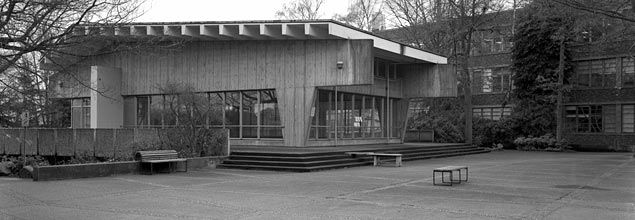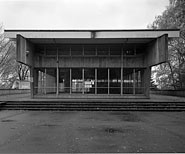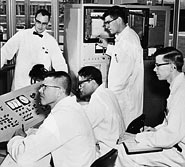The University of Washington Nuclear Reactor Building: Artifact in the Landscape

Constructed as the “crown jewel” of the UW Engineering Department, the Nuclear Reactor Building and plaza was the result of an interdisciplinary design team, The Architect Artist Group, but is now shuttered.
The University of Washington in Seattle boasts one of the most beautiful campuses in the country, sited with a sweeping vista of Mt. Rainier, fastidiously kept grounds, and buildings which are monuments to excellence in academics. John C. Olmsted, of the Olmsted Brothers firm, first established the layout of the campus with his plan for the Alaska-Yukon-Pacific Exposition in 1909, and the University has gradually overlaid its physical history upon this site for the past century. All of the buildings and open spaces of the campus are realizations of the goals of the institution, and much about the history of the University can be read in the historic designed landscapes and structures of the campus.
The Nuclear Reactor Building was constructed in 1961 to be the “crown jewel” of the University of Washington’s Engineering Department. It was built to house a small research reactor for student training and experimentation. At that time, nuclear engineering was a cutting-edge technology, offering the promise of cheap energy and a better life. The University intended the Nuclear Reactor Building to exemplify its commitment to science and to the future. Research reactors were installed on many college campuses, but the reactor at the University of Washington was the only instance where nuclear technology was boldly presented to the public. The Nuclear Reactor Building was designed with walls of glass for observation of the activity inside, a completely novel approach. All sides of the building overlooked the central reactor room and were accessible by a broad concrete observation deck. Engineering faculty recall that during the early years of the building’s use, people were crowded 10 deep on the observation deck during the annual engineering open house.


(Top + Above) Courtesy Abby Martin
(Bottom) Contol Room. Courtesy University
of Washington Facilities Office
The innovative design of the building and plaza was the result of close cooperation between the Nuclear Engineering Department and an interdisciplinary design team, The Architect Artist Group [TAAG], which included important Pacific Northwest Architects Wendell Lovett, Gene Zema, and Daniel Streissguth. Together, TAAG and the nuclear engineering department produced a visionary design for a building showcasing the reactor and its activities behind walls of glass, surrounded by an observation deck. The building was hailed as exemplary of cooperative design and progressive education and was published internationally as an architectural and educational achievement.
The Nuclear Reactor Building was designed as much for the experience of the person on the outside of the building as the occupant inside. The siting of the building within a triangular open space walled by larger buildings directs the flow of traffic across the site and forms an articulated exterior space, in which the building itself is an object on display. The building sits off center within the open space opening towards a view of the football stadium and Lake Washington. The outward focus of the building’s purpose is further emphasized by the concrete plaza adjacent to the building (designed and constructed simultaneously with the building) and the observation deck. In contrast to the majority of the academic buildings on the campus, which are inward-focused and communicate little of the activity inside, the Nuclear Reactor Building projects its purpose and energy. The dynamic Modern building is an embodiment of the optimism for technology which inspired its design.
The cultural landscape of the campus, although constantly changing, can be read in the layers of buildings and landscapes added over time, which collectively reflect broader national and local trends. The Nuclear Reactor Building is a prime example of this phenomenon with its clear visual and functional connection to the social trends of America in the years shortly following WWll. Built for the highly specific purpose of housing the reactor, the building’s fate was tightly bound up with that of nuclear power. After growing fears and social resistance to nuclear technology in the 1970s, demand for its applications faded, and the Nuclear Engineering program at the University of Washington closed in the 1980s. The Nuclear Reactor Building has been empty and abandoned since that time.

Courtesy University of Washington Facilities Office
In spring 2008, the University applied to the City of Seattle for a permit to demolish the building and surrounding plaza. While the Department of Planning and Development (DPD) conducted an environmental review of the proposal, DPD received many comments from concerned citizens stating that the Nuclear Reactor Building is architecturally and historically significant and should not be demolished. During this time, the Western Washington Chapter of DOCOMOMA worked with other preservation organizations and the Friends of the Nuclear Reactor to advocate preservation of the building, including urging the University to review alternatives to demolition.
More recently, the Governor's Advisory Council on Historic Preservation reviewed the National Register of Historic Places nomination for the Nuclear Reactor Building at its October 2008 meeting. While the University formally objected to the nomination, the council voted to list the building on the Washington Heritage Register and to forward the nomination to the National Park Service and the national Advisory Council on Historic Preservation for inclusion in the National Register.
The University of Washington has undertaken a Supplemental Environmental Impact Statement (SEIS) for the building and are reviewing alternatives for the site. Their preferred action continues to be demolition, however, the full Draft SEIS is expected to be released by May 2009.
The Nuclear Reactor Building is a singular Modern design on a campus that boasts a rich built history. The University has been a vigilant steward of many of its historic resources, but recently the what and why questions of preservation on the campus have again come into opposition with the constant demand for campus growth. The issue in question is whether this Modern building will merit a place in the built history of the campus and, if so, the role it will play as part of an ever-evolving institution. The recent threat of demolition and claims by the University that the Nuclear Reactor Building is not worthy of preservation has instigated a renewed interest in the site. While the small Modern building was until recently largely forgotten, it was once a center of activity. Today, it continues to be a unique contribution to the campus’ cultural landscape, but it is also a significant part of the Nation’s legacy of science and technology and as such merits a solution that emphasizes its ongoing care and management.



